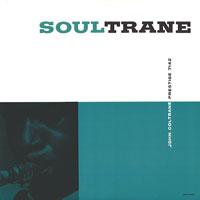Soultrane Reissued Yet Again
The monophonic master tape of this 1958 Prestige session recorded at Rudy Van Gelder’s Hackensack home studio has probably had more tape head contact over the past few years than it had for the first 30 plus years of its life. Along with this 2 LP set and SACD, there’s a 180g Acoustic Sounds LP still in print, there was a 1998 JVC XRCD reissue, a 1993 DCC Compact Classics gold CD, a standard CD, a 20 bit mastered edition, a Japanese 20 bit “LP sleeve” edition and probably a few others as well. Do a search on Amazon.com and you’ll find a confusing jumble of Soultrane editions priced from $6.49 to $49.00 (the out of print DCC Compact Classics gold CD), none of which are identified in adequate detail. As you’d expect, www.acousticsounds does a better job of identifying this recording’s many iterations.
Why such interest in this album? Musically, it’s understandable: Coltrane, backed by Red Garland’s nimble trio, stretches out on 5 tunes and steps out from whatever shadow Sonny Rollins might have previously cast on his originality. Garland’s trio provides a bracing backdrop for both Coltrane’s ballad lyricism and hard-bop muscularity.
The opener, “Good Bait,” a catchy tune written by Todd Dameron and Count Basie, and first recorded by Dizzy Gillespie, gets nimbly stretched and pulled apart in Coltrane’s darting, swooping solos. Garland’s first solo fingerings get as close to producing a continuous piano glissando as you’re likely to hear, and Paul Chambers follows with a rubbery, good humored turn. This is jazz of the exuberant, brawny variety, not requiring intellectual analysis to appreciate.
The slow moving ballads, “ I Want to Talk About You,” and “Theme For Ernie,” allow Coltrane to extract richer, breathier and more rounded tones from his instrument. Sax lovers will revel in the pure full sound Coltrane gets on these laid back grooves. For sheer excitement though, the bracing pace of the set’s finale, Irving Berlin’s “Russian Lullaby,” can’t be beat. After a slack-tempo Garland intro, the quartet launches the tune as if from a rocket sled, with Coltrane jumping all over the melody The thick sonic curlicues Coltrane produced, inspired music critic Ira Gitler to invent the term “sheets of sound,” to describe Coltrane’s emerging technique.
Soon after this session, Coltrane would go into the studio with Miles Davis and make his contribution to the modal masterpiece Kind of Blue. Conceptually, there’s nothing here as earth-shattering as that, but the playing is superb and it was Coltrane’s launch pad for the monumental explorations that would soon come.
Sonically, this is not a particularly distinguished recording, though it does have some notable qualities. Coltrane’s out-front sax is fairly well-recorded (though there is some distortion on the opening track), with a juicy, three-dimensional quality and a nice balance of reed and brass. Chambers’s bass has decent weight and body, and Arthur Taylor’s drum kit is cleanly rendered. The usual Van Gelder boxy piano of the era asserts itself though, bringing the sonic picture down a few notches. What really saves the day sonically, is the purity and simplicity of the recording. Despite the shortcomings, musical intimacy is maintained, and with so little between the mics and your ears, it’s an exciting step back in time, aided by SACD’s resolution.
For digital domainers, the SACD is, to my ears, the best of the lot, with the XRCD being somewhat warmer but less detailed and not quite as coherent overall, or rhythmically as adept. The DCC Gold CD shows its age, but truthfully, if you have either of those, buying this music yet again on SACD is not a particularly good investment, unless your resources are limitless. If you don't have this recording and you're in the digital domain, get the hybrid SACD and be done with it!
The LP is another story entirely. It doesn’t make a less than stellar recording to begin with, great—that’s impossible—but it is easily the best edition of Soultrane that I’ve ever heard. There’s more wood and harmonic complexity to Garland’s piano, greater “reediness” to Coltrane’s sax, and more of Van Gelder’s living room studio apparent in the ambience. Just don’t expect sonic miracles. Not a giant step in Coltrane’s recorded output, but one guaranteed to bring long term listening pleasure.




